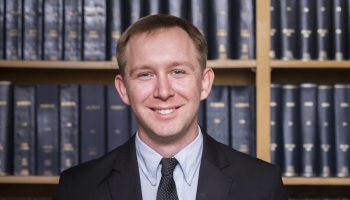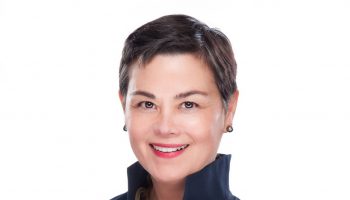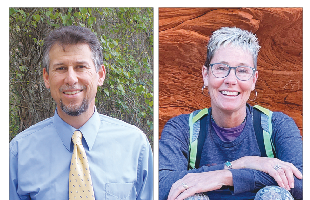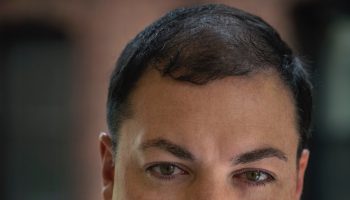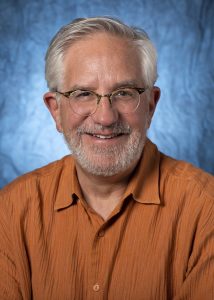
In partial celebration of the Chautauqua Women’s Club’s 130th anniversary, Wes Cowan is taking on separate but related roles. One is similar to his “Antiques Roadshow” persona, and the other is more akin to his former “History Detectives” persona.
Wearing his appraiser’s hat on Friday afternoon, Cowan kicked off the CWC’s weekend celebration by leading a “Road Show”-themed event, during which he provided valuations of 20 items of personal property brought to him by Chautauquans who had purchased VIP tickets in advance.
At 2 p.m. Saturday, July 20 in the Hall of Philosophy, Cowan will switch to his history hat and talk about “The Things We Keep: History with a Little H,” as part of CWC’s Contemporary Issues Forum.
“I’ve been with (the American version of) ‘Antiques Roadshow’ since its second season,” he said. “And for 11 years I was co-host of ‘History Detectives.’ Those two experiences inform the thesis of my talk. Every American has a story to tell. Those stories connect us to history. Our family’s relationship with these two concepts is changing and is going to continue to change.”
At an early age, Cowan’s own family story began connecting him to American history. Years before he started scientifically studying the origin, culture and development of humans, he gained firsthand experience collecting and unearthing historical objects.
“I grew up in Louisville, Kentucky,” Cowan said. “I was a weird kid. I was drawn to old things. My mother took me to auctions. … I also rode my bike to local antique shops when I was 10 and 11 years old, and all the old men and women who ran them thought it was kind of cute.”
He said that a friend gave him a chipped stone arrowhead, and he wanted to know all about it.
“I turned to the local archaeological society … and my mother took me to local places where I could find arrowheads and other artifacts,” Cowan said.
Relatives in western Kentucky owned farms, and he said he spent summers working on them. Uncovering more arrowheads, Cowan sought out the museum of anthropology. His academic path in anthropology was set in motion, when at age 15, he worked on his first dig.
At the University of Kentucky, Cowan earned his Bachelor of Arts, and then his Master of Arts, in anthropology.
Three years later, in 1980, he completed his doctorate at the University of Michigan, joined the anthropology faculty at The Ohio State University, began teaching archaeology, and continued his fieldwork. His research interests included the archaeology of North America and the origins of agriculturally-based economies.
“I was very interested in the origins of agriculture in eastern North America,” Cowan said. “I’ve written extensively about paleoethnobotany, … the study of the interrelationships of plants and past civilizations.”
From 1984 to 1994, Cowan served as curator of archaeology and chair of the Department of Anthropology at the Cincinnati Museum of Natural History. He said that during those 11 years, he continued his research. In 1987, the museum published his report, “First Farmers of the Middle Ohio Valley: Fort Ancient Societies, A.D. 1000-1670.”
All the while, Cowan continued antiquing.
“In grad school I became very interested in not writing my dissertation,” he said.
Taking “respite from the grind of school,” he stopped at old shops and antique stores on the back roads of southeastern Michigan, purchased items he could afford — “photographs of 19th-century America” — and learned about American history and photography.
In Cincinnati, Cowan began turning this knowledge and his acquisitions into a side business of “buying, selling and trading with collectors the world over.” He converted his garage into a makeshift office and conducted auctions by mail and telephone.
“In 1994, I was asked to do an appraisal of a 19th-century photo,” Cowan said. “After the lawyer asked, ‘What do I do now?,’ I sold it at auction.”
He left the natural history museum in 1995 to become a licensed auctioneer and establish Cowan’s Auctions in Cincinnati. Initially, he focused on early photographs, historical manuscripts, maps and political ephemera.
Because his business grew rapidly over the next few years, Cowan began hiring specialists in Native American art, furniture, decorative art, paintings, jewelry, antique firearms and 20th-century studio ceramics. He also added two offices — in Cleveland and Denver.
As he added staff, Cowan said he “hired people who were academics” and advised them to “pull the thread, pull the string and see where it leads — the more information you can provide to a potential buyer, the better off it will be.”
Cowan’s Auctions’ tagline is: “Bringing exceptional objects to sophisticated buyers with passion, respect and integrity.”
As his business grew, Cowan maintained his interest in paleoethnobotany and his connections with the academic community.
He made the time to co-edit three books, two of which included his own research on the late prehistoric and protohistoric Fort Ancient societies in the central Ohio Valley: Societies in Eclipse: Eastern North America at the Dawn of European Colonization; The Origins of Agriculture: An International Perspective, and Societies in Eclipse: Archaeology of the Eastern Woodlands Indians, A.D. 1400-1700.
In January, according to Cowan, a company that had purchased Leslie Hindman Auctioneers, founded in Chicago in 1982, also bought Cowan’s Auctions. They merged to form Hindman, LLC, which has locations in 10 cities, including in the southeastern United States.
“We have a greatly expanded footprint now, which allows us to touch even more people,” Cowan said. “In 2018, (Cowan’s Auctions) had 50 employees and $17 million in annual sales. … In 2019 (Hindman has) 150 people and annual sales of $67 million. We’re the largest fine arts auctioneers in the Midwest, and one of the largest in the country, with international reach.”
In addition to growing his business and keeping abreast of anthropological research, Cowan said he spent years in front of a national audience each week.
“When I was doing both, it was incredibly time consuming,” Cowan said. “There were long periods of absence. I couldn’t have done this without great people. I credit them with everything.”
Twelve to 13 million people watched “Antiques Roadshow” every week, Cowan said.
“It’s tough to maintain momentum after 24 years, (yet) it’s still the No. 1 most popular show on PBS, period,” he said.
The documentary television series “History Detectives” aired from 2003 to 2013. In 2014, both its format and name were changed. “History Detectives: Special Investigations” was discontinued, though not officially canceled, the following year.
Cowan, who co-hosted both versions, said that 110 episodes were produced.
“Very few shows have that longevity,” he said. “It tapped into a deep vein of interest.”
“Roadshow” and “Detectives” spawned a series of knock-off shows, including “Pawn Stars” and “American Pickers.”
“Of all the TV reality shows, ‘Antiques Roadshow’ and ‘History Detectives’ are the only ones not made up,” Cowan said. “Particularly, ‘AR’ — it’s pure as the driven snow.”
At least one instance — the mystery of the black Confederate soldier, an item Cowan appraised during a 2010 “Antiques Roadshow” episode — led to him hosting a “History Detectives” episode.
Cowan’s findings concerning the tintype photo of two young soldiers — one white and one black, and both dressed in Confederate uniforms — negated the stories that two West Point, Mississippi, families with the surname of Chandler had been telling for many years. Consequently, their relationship with each other and with Civil War history changed.
Silas Chandler, often misunderstood to be a willing black Confederate soldier, was a Mississippi slave forced to fight in the Civil War alongside his white owners. Photographs, like the 160-year-old tintype of Silas and his owner Andrew Chandler, have historically been used to fuel narratives of willing black Confederate soldiers.
Through Cowan’s research, he proved that the photo of Silas and Andrew could no longer be used as evidence that slaves, or former slaves, willingly fought against the Union Army.


